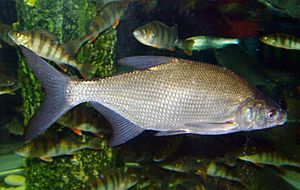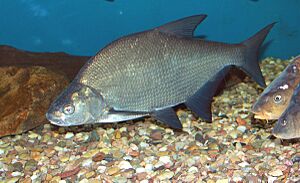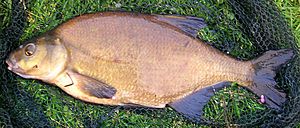Common bream facts for kids
The common bream (Abramis brama) is a type of freshwater fish found in Europe. It's also known by names like freshwater bream or bronze bream. This fish belongs to the Cyprinidae family, which includes carps and minnows. It is the only species in its group, called Abramis.
Quick facts for kids Common bream |
|
|---|---|
 |
|
| Common bream (Abramis brama) | |
| Conservation status | |
| Scientific classification | |
| Genus: |
Abramis
|
| Species: |
brama
|
| Synonyms | |
|
|
Contents
Where Common Bream Live
Common bream are found across Europe. Their home is north of the Alps and Pyrenees mountains. You can also find them in the Balkans. They live as far east as the Caspian Sea, the Black Sea, and the Aral Sea. These fish prefer to live in ponds, lakes, canals, and slow-moving rivers.
What Common Bream Look Like
A common bream is usually 30 to 55 cm (12 to 22 in) (about 12 to 22 inches) long. Some have been recorded at 75 cm (30 in) (nearly 30 inches). They typically weigh 2 to 4 kg (4.4 to 8.8 lb) (about 4 to 9 pounds). The biggest recorded bream was 90 cm (35.5 in) long and weighed about 9.1 kg (20 lb).
The common bream has a body that is flat on its sides and tall on its back. Its mouth is slightly set back, pointing downwards. Young bream are silvery grey. Older fish can turn a bronze color, especially in clear water. Their fins are grey or black, never reddish.
Spotting Similar Fish
It's easy to mix up the common bream with the silver bream. This is especially true when they are young. To tell them apart, count the scales in a straight line from the first ray of the dorsal fin down to the lateral line. Silver bream have fewer than 10 rows of scales. Common bream have 11 or more.
When they are adults, the silver bream has a reddish tint on its pectoral fin. This is a clear sign. Like other fish in the Cyprinidae family, common bream can hybridize with other species. Hybrids with roach can be very hard to tell apart from pure-bred bream.
Where Bream Prefer to Live
Common bream usually live in rivers, especially the slower parts. They also like lakes and ponds that are rich in nutrients. These places often have muddy bottoms and lots of algae. You can even find them in salty sea waters that are not too salty (brackish water).
What Common Bream Eat
Common bream live in schools, swimming together near the bottom. At night, they might come closer to the shore to feed. In clear water with sandy bottoms, you can see their feeding pits during the day. Their special mouth can stick out. This helps them dig for insect larvae like chironomids, Tubifex worms, bivalves, and snails. Bream also eat water plants and tiny floating organisms called plankton.
In very cloudy waters, many common bream can live together. This can lead to a shortage of food on the bottom. When this happens, bream have to eat by filter feeding. They use their gill rakers to catch tiny Daphnia water fleas. As the fish grow, their gill rakers get too far apart to catch small prey. Then, the bream won't grow bigger than 40 cm (16 in). If a common bream doesn't get enough food, its back can become very thin and sharp. This is called a "knife back."
How Common Bream Reproduce
Common bream lay eggs from April to June. This happens when the water temperature is around 17 °C (63 °F). During this time, male bream create small territories. Females then lay 100,000 to 300,000 eggs on water plants.
The tiny fish hatch after three to 12 days. They stick to water plants using special sticky glands. They stay there until they use up the food from their yolk sac. Young bream are often not recognized as bream because they are so slender. But you can spot them by their flat bodies and silvery color. At this stage, they swim freely in the water. After a few months, they get their usual body shape and start living near the bottom. By three to four years old, the fish are ready to reproduce.
Fishing for Bream
The common bream is not usually caught to be eaten. However, common bream are popular with people who fish for sport or in competitions. They are not as hard to catch as other fish in the UK. This is because their flat, disc-shaped body makes them relatively easy to pull in.
Bream will eat most baits. Some good ones are:
- Sweetcorn - use two or three grains on the hook.
- Maggots/worms - put two or three directly on the hook.
- Boilies - bream have large mouths and can eat most boilies.
You can catch bream in rivers or lakes. It helps to use a lot of groundbait to attract groups of them. They are not shy fish. Fishing with a float on the bottom is one way to catch them. Another method is ledgering. This means using a lead weight to hold the bait down. A cage feeder full of bait often works better on bigger rivers and lakes.
The current record for a common bream is over 10 kg (22lbs). This fish was caught in 2012.
See also
 In Spanish: Brema para niños
In Spanish: Brema para niños





